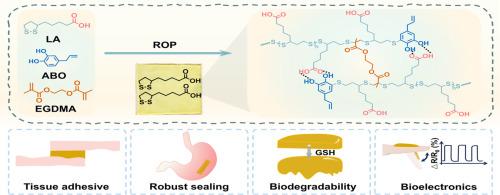自增强聚硫辛酸基坚韧水下组织生物胶粘剂。
IF 9.6
1区 医学
Q1 ENGINEERING, BIOMEDICAL
引用次数: 0
摘要
由于水合层的阻碍和粘合剂的膨胀,生物粘合剂在潮湿/水下组织上的强而持久的粘附仍然是一个挑战。本文采用溶剂蒸发诱导自聚合法制备了聚硫辛酸(PolyLA)包覆4-烯丙基-1,2-苯二醇(ABO)的水致自硬化生物粘合剂(p(LA-ABO))。在水下固化过程中,生物胶粘剂疏水聚乳酸链的水诱导聚集导致软硬过渡,从而增强了生物胶粘剂的内聚性和湿/水下组织的粘附性。在6 h的湿粘接过程中,其抗拉强度由57.77 kPa提高到93.87 kPa,粘接强度由50.48 kPa提高到80.59 kPa。而且,在水下粘附6小时后,仍能保持牢固的附着力而不减弱(~ 85.09 kPa)。此外,在水浸泡12小时后,粘合剂表现出非常低的肿胀(~ 1.1%)。它还具有按需剥离、良好的生物相容性和生物降解性。通过将导电织物夹在两种生物粘合剂之间,可以制造出具有高导电性的应变传感器,用于感应身体运动信号。这种水诱导自硬化湿粘附与传感性能的结合可能为湿/水下应用生物传感器的设计开辟了一条新的途径。意义声明:生物胶粘剂由于其广泛的工业和生物医学应用而受到越来越多的关注。然而,尽管付出了巨大的努力,但由于界面水屏障的存在,以简单有效的方式实现强大、稳定、持久的湿/水下粘附仍然是一项挑战。为了解决这个问题,我们设计了一种水诱导自硬化聚乳酸基生物粘合剂,具有持久和强大的湿/水下粘附性。此外,通过将这种生物粘合剂与导电棉织物相结合,创造了一种对人体运动信号高度敏感和快速响应的应变传感器,扩大了其在潮湿环境中的应用范围。因此,本研究为开发湿/水下生物传感器提供了一种新的方法。本文章由计算机程序翻译,如有差异,请以英文原文为准。

Self-reinforceable poly(lipoic acid)-based tough underwater tissue bioadhesive
Strong and durable adhesion of bioadhesives on wet/underwater tissues is still challenging because of the hindrance of the hydration layer and swelling of the adhesive. Here a water-induced self-hardening bioadhesive (p(LA-ABO)) composed of poly(lipoic acid) (PolyLA) capped with 4-allyl-1,2-benzenediol (ABO), is prepared through a solvent evaporation-induced self-polymerization method. During underwater curing, the water-induced aggregation of the hydrophobic PolyLA chain of the bioadhesive leads to a soft-to-hard transition, therefore enhancing its cohesion and wet/underwater tissue adhesion. Its tensile strength and adhesion strength on wet porcine skin respectively increased from 57.77 kPa to 93.87 kPa and from 50.48 kPa to 80.59 kPa in 6 h wet adhesion. Moreover, it can still maintain robust adhesion without weakening (∼85.09 kPa) after 6 h of underwater adhesion. Additionally, the adhesive exhibits a very low swelling (∼1.1%) after 12 h of water immersion. It also shows on-demand detachment, good biocompatibility, and biodegradability. By sandwiching a conductive fabric between two bioadhesives, a strain sensor with a high conductivity is created for sensing body motion signals. This integration of water-induced self-hardening wet adhesion with sensing performance may open a new avenue in the design of biosensors for wet/underwater applications.
Statement of significance
Bioadhesives have gained growing attention owing to their wide industrial and biomedical applications. However, despite significant efforts, it remains challenging to achieve strong, stable, and durable wet/underwater adhesion in a simple and effective manner due to an interfacial water barrier. To address this issue, we engineer a water-induced self-hardening PolyLA-based bioadhesive with durable and robust wet/underwater adhesion. Furthermore, by integrating this bioadhesive with conductive cotton fabrics, a highly sensitive and rapidly response to body motion signals strain sensor was created, expanding its application range in wet environments. Therefore, this research offers a new methodology for developing wet/underwater biosensors.
求助全文
通过发布文献求助,成功后即可免费获取论文全文。
去求助
来源期刊

Acta Biomaterialia
工程技术-材料科学:生物材料
CiteScore
16.80
自引率
3.10%
发文量
776
审稿时长
30 days
期刊介绍:
Acta Biomaterialia is a monthly peer-reviewed scientific journal published by Elsevier. The journal was established in January 2005. The editor-in-chief is W.R. Wagner (University of Pittsburgh). The journal covers research in biomaterials science, including the interrelationship of biomaterial structure and function from macroscale to nanoscale. Topical coverage includes biomedical and biocompatible materials.
 求助内容:
求助内容: 应助结果提醒方式:
应助结果提醒方式:


